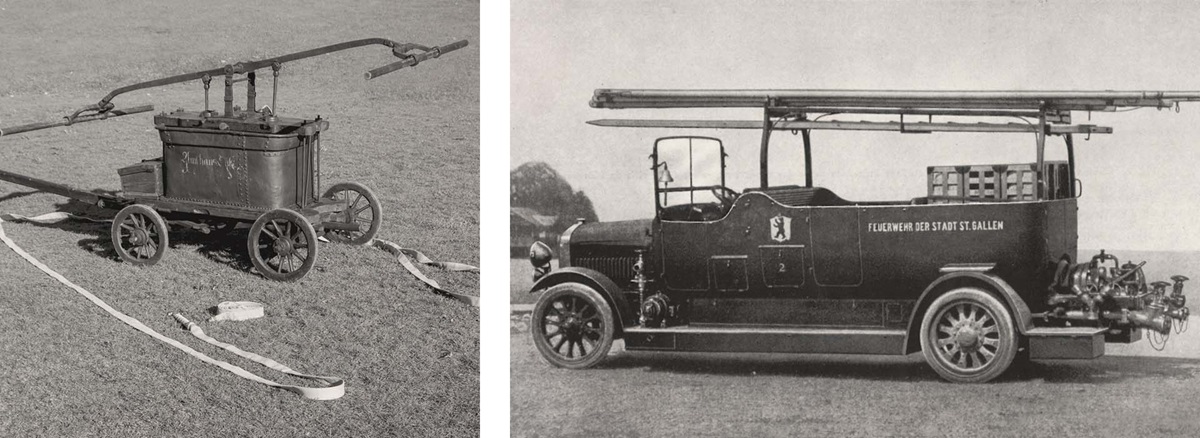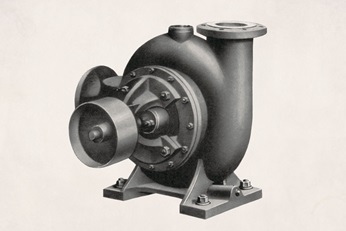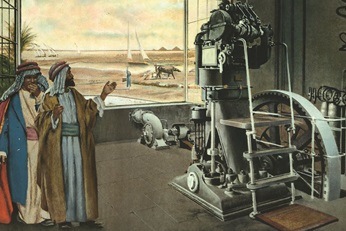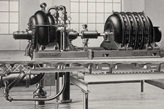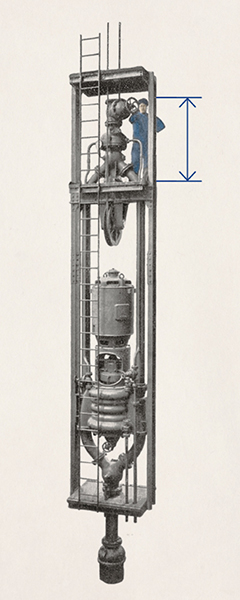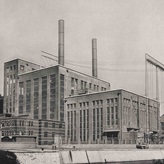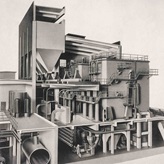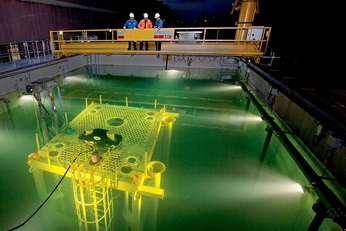Sulzer Technical Review Issue 3/2019
November 27, 2019Innovative pumps for 185 years
The first fire extinguishers delivered by Sulzer in 1834 were hand-operated (Fig. 1). In 1923, Sulzer supplied fire pumps for motorized fire engines (Fig. 2).
Since the company was founded, the range of applications for its centrifugal pumps has been extended from irrigation and drainage to drinking water.
Subsequently, pumps were developed to support energy generation in power plants. Storage and hydroelectric power stations were the initial customers for these large pumps. Due to their reliability and high efficiency, centrifugal pumps are used in fossil and nuclear power plants as well as in gas and steam power plants.
Applications of Sulzer pumps
Sulzer pumps — whether they are pipeline, injection, multiphase or subsea pumps — are the technology drivers in oil and gas production and the petrochemical industries. With the rise of sustainable power generation processes, Sulzer pumps are also used in solar power plants and for energy recovery. Pumps for large-scale installations are designed, calculated, manufactured and tested specifically for each customer. Sulzer offers pump solutions for drinking water, water and wastewater management, as well as accessories for water treatment. In general industry applications (paper, beverages, food, fertilizer, desalination, etc.), Sulzer’s rugged and energy-saving pumps meet the highest demands.
History of pump manufacturing at Sulzer
Sulzer has been mass-producing centrifugal pumps since the 1860s (Fig. 3). At first, Sulzer pumps were mostly used as wastewater pumps, in ore processing, and as brine-circulating pumps in refrigeration plants.
Pumps for irrigation and drainage
From 1890 onwards, Sulzer manufactured drainage pumps for Egypt (Nile Delta) and for other countries. At the Codigoro pumping station in Northern Italy, for example, the company supplied five axial pumps with vertical shafts that each achieved a flow rate of 28’800 m3 per hour and a delivery head of 4–5 meters.
Sulzer’s centrifugal pumps for large-scale irrigation were first used in 1892. At that time, the first major plant, which had a total pumping capacity of 6’500 m3 per hour, was installed in Egypt for the Say refinery (Fig. 4). Spiral housings with cast guiding ribs were already used to handle these quantities of water back in the 19th century. The first pumps had a belt drive, and the subsequently designed large installations featured direct coupling of the pumps to steam engines, diesel engines or electric motors.
The design of sewage pumps with a vertical shaft eliminated suction issues. Sulzer has been optimizing its hydraulics continuously since the last century. Double-curved impeller blades with optimized suction efficiency made it possible to increase the speed of the pumps.
High pressure thanks to electric drive system
The installation of electric motors for power transmission resulted in increased delivery heads. Sulzer first tested this technology when the company installed electric motors in a multistage pump in 1894. There were three impellers connected in series on a vertical shaft; the impellers were separated from one another by spacers. This pump was designed for the world’s first hydraulic power storage system.
The first high-pressure centrifugal pump was introduced in 1896. The municipal waterworks in Geneva (Fig. 5) ordered a large multistage pump directly coupled to a 1’000 hp (735 kW) electric motor that lifted 1’350 m3 of water per hour to a height of 140 meters. The first Jet d’Eau (water fountain) in Lake Geneva was used at that time to release excess pressure from this system. Later, Sulzer pumps were used to permanently operate this fountain (Fig. 6).
Borehole pumps for wells and mines
To do away with the need for well shafts, Sulzer developed borehole pumps in 1910. They became popular very quickly and were also used in mines. The first pump had a 24 m drive shaft. Versions with a 170 m drive shaft and a drive power of 800 hp (590 kW) were in operation as early as 1930. At that time, Sulzer was already building underwater electric pumps that did not have a vertical shaft, but instead featured a design where the motor was integrated directly on the pump.
The high-pressure centrifugal pump tapped into a huge market potential that had previously been completely dominated by piston pumps. The first high-pressure centrifugal pump was ordered in 1898 to dewater the Horcajo lead and silver mine in Spain down to a depth of 390 meters. This system worked with several pumps arranged on top of each other on different levels, while a pumping water column established a force-lock connection among these pumps. These mine pumps were already directly coupled to electric motors (Fig. 7).
Ingenious design provided relief
Another major step forward in the design of the multistage pump was the introduction of the balance disk in 1905. Initially, the axial forces were largely balanced using impellers arranged in pairs. Balance pistons and ball or journal bearings absorbed the residual forces. The advent of the balance disk made it possible to arrange only in-line impellers across the entire shaft and fully neutralize the axial thrust.
Storage pumps for hydropower
With the expansion of hydroelectric power plants along rivers, the storage of power gained in importance. High-level tanks were built to increase the efficiency of power plants. For the Hüssy weaving mill in Italy, Sulzer built the world’s first storage pump in 1894. In 1904, Sulzer built the first large storage pump system with an 800 hp (590 kW) high-pressure pump for the Olten-Aarburg power station. Another noteworthy milestone is the installation of giant pumps for the Niederwartha storage facility near Dresden with a unit output of 27’000 hp (19.9 MW) in 1929. The world’s largest — at the time — pumped storage plant was installed in Wales in 1957. It employed four vertical, two-stage double-flow pumps with 69.7 MW of drive power each. Figs. 8 and 9 show how large these high-pressure pumps were.
Full steam ahead
As steam power plants got increasingly larger, centrifugal pumps were used to feed boilers from 1912 onwards. These pumps were built to withstand temperatures of up to 200°C (392°F) and operating pressures of over 100 bar. Sulzer designed thermal power plants for the generation of electricity and steam.
Fig. 10 shows a model for a power and steam generation plant from 1946 and Fig. 11 shows a realized plant from 1950. In 1975, Sulzer installed the largest boiler feed pump in Europe at that time in the Dutch town of Maasbracht. The largest turbine-driven boiler feed pump (47.5 MW) was delivered to Neurath, Germany, in 2006 (Fig. 12).
Milestones in the evolution of pumps
Injection pumps are used in the oil and gas sector. In 1975, Sulzer installed 13 duplex injection pumps in Algeria for the first time in the company’s history. The two largest injection pumps, each with 15.7 MW, were delivered to Saudi Arabia in 1977, but this record was already broken in 1981, when Sulzer shipped and installed two 18.8 MW pumps to Alaska, US. In 2002, the drive power of the largest injection pumps had already reached 27 MW.
In the Gulf of Mexico, high-pressure injection pumps with a pressure of 605 bar were used for the first time in 2001 secondary oil recovery from the reservoir. In 2011, Sulzer began developing a concept pump with 800 bar for seawater injection. This pump was been tested successfully in 2019 at full size.
The two largest offshore multiphase pumps for oil-gas-water mixtures with a drive power of 4.5 MW each were installed in the North Sea in 1999. In 2000, the two largest multiphase pumps with a drive power of 6 MW each were delivered to Russia. A Sulzer multiphase pump (Fig. 14) was installed 1’800 m below sea level in 2018.
Pipelines for oil or water
Sulzer is also the leading provider in the pipeline pump market. The first pipeline was put into operation in 1934, and led from Kirkuk in Iraq to the Mediterranean Sea (Fig. 15). In 1985, Sulzer installed 100 pumps for the longest pipeline across Canada and the US. The world’s largest pipeline pumps with a drive power of 14.5 MW were installed in Russia in 2008. In the same year, the longest Canadian crude oil pipeline was fitted with Sulzer pumps.
The leading pumps for the pulp and paper industry
Ahlström in Finland was a leading supplier of pumps for the pulp and paper industry. Through the acquisition of Ahlström Pumps in 2000, Sulzer has become a global leader in innovative and reliable pump, agitator and mixing solutions for the pulp and paper industry. The acquisition of Cardo Flow Solutions in 2011 expanded Sulzer’s complete product portfolio for the pulp and paper industry with ABS submersible pumps and HST turbo compressors, which can also be used in other process industries.
Sulzer’s deep process and application knowledge is based on long-term close co-operation with the producers, machinery suppliers and engineering companies.
Optimization of development and capture of pump data
Less spectacular, but just as important, are projects such as the development of new impellers, the optimization of pump hydraulics, and process optimization options. The use of the most suitable pump material, adapted to the medium to be pumped, has always been an essential aspect of pump design at Sulzer. As early as in the 1920s Sulzer produced acid pumps for the production of nitric acid, for which V2A material (nickel-chromium steel) was used.
Sulzer patented the first clog-free impeller for wastewater pumps in 1996. CFD calculations were used at Sulzer in the late 1980s. A CFD-optimized impeller was patented in 2009, and in 2013 Sulzer launched the first CFD-optimized multichannel impeller.
With the introduction of the first pumps for medium consistency materials in 1980, Sulzer helps to save energy in pulp, paper and board production as well as in other industrial processes. Integrated degassing, first introduced to the market in the 1980s, is a key decision criterion for Sulzer pumps in many industrial processes.
Sulzer launched its Industry 4.0 initiative in 2017. BLUE BOX™ is an innovative, cloud-based data analytics platform developed by Sulzer. BLUE BOX is able to analyze data from pump and pipeline equipment of any manufacturer, helping operators optimize their plants, operate them more efficiently, and streamline maintenance.
In order to offer such a broad range of pumps and pump accessories, Sulzer acquired companies around the world and integrated them into the Sulzer family. The most important milestones in the expansion of the business are shown in Fig. 16.
Sulzer Technical Review
Editor-in-Chief


